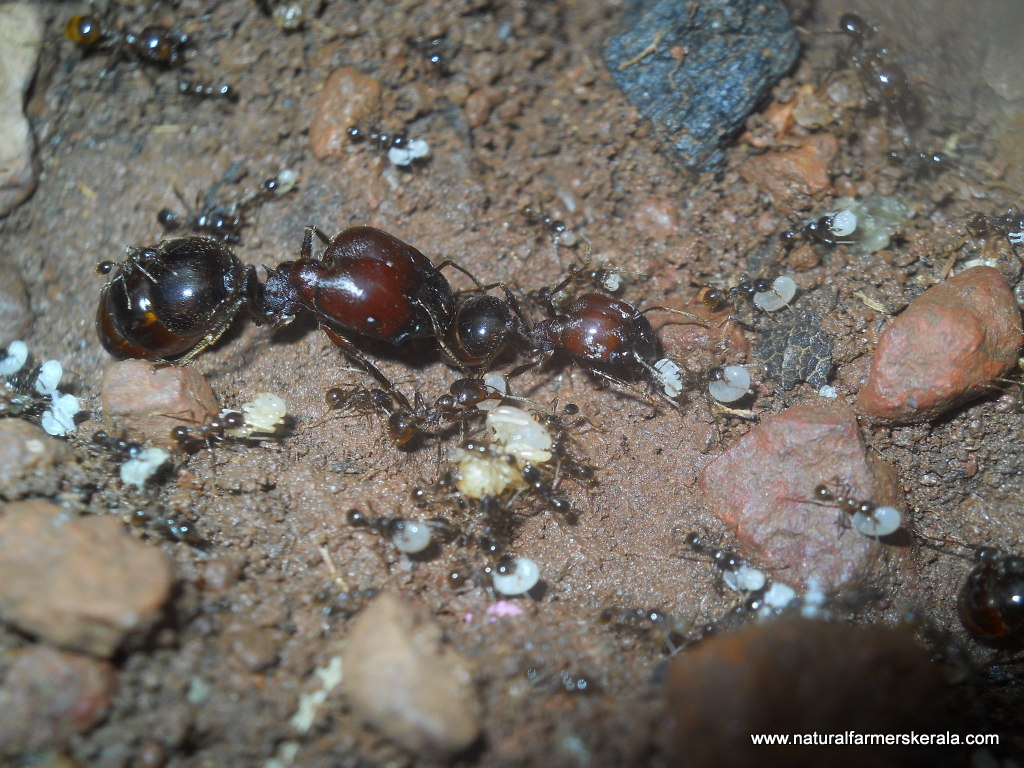Some Interesting and Good to know Facts of Ants(Urumbu)

There are many things Ants can teach Humans. Provided you respect and understand them. Ants work a lot which directly or indirectly help humans in their farming and other activity. Humans would have learned the art of storing food for future consumption through ants, bees and other small creatures.
Ants are the Best Indicators of Approaching Monsoon.
When you see Spiny Harvester Ants(black with reddish shade – in Kerala it is known as Karthe Ney Urmbu) carrying their eggs from a lower nesting site(where flooding can happen) to a higher location it is a definite sign of monsoon arrival in 2 days, they are amazingly good at rainfall predication. They predict rains before hand and according make new arrangements. I have personally witnessed ant movements following rains since last 3 years. It has always rained.
One interesting fact is meteorological department forecast weather depending on available data(satellite images, some understanding of local atmosphere, using barometer etc). It has been able to help save people and property loss to some extend. severe winds, thunderstorms, fog and flood have been effectively predicted on day-to-day basis which is also known as short term forecasting. They are only good at last moment forecast after getting a clear picture. For eg they can see an upcoming cyclone or tsunami coming but are not precise at predicting where it will land. However when you see this ants carrying their eggs. It will surely rain where you see the ants. 5 or 10 km away from where you spotted the ants, it may or may not rain. That is the beauty of nature. You will see these ants mostly during the evening hours near by your house. Because they normally live in wall crevices and cavities. They are small black ants found throughout India(Harvester ants are the ones that bite and are very aggressive, their bite marks swells and itches. They feed on variety of insects and dead meat).
Ants can also predict earthquakes in advance
This is nothing new to Indians but yes to the new generation. Black ants would spread all over your house or veranda unlike their normal trailing patter in-line with other ants, This is a sign of abnormal activity happening with earth, may be earth quakes are approaching. It could be electric currents or some strong waves they detect There are many more animals and their strange pattern used as an information of approaching earthquake or other natural calamities. Sad part is most of the traditional knowledge is lost forever. In Sushruta Samhita about wound healing there is reference of soldier ants jaws used to staple open wound and then their body being pinched off. Ants also eat the same refined sugar which we eat which causes various types of illness as per modern science. But does that affect them?? They are well organised and are ready to take on any type of situation. Did you know an ant can survive a fall from tall trees because of terminal velocity, as seen in parachutes. Elephants normally keep away from ants because they can get into their nostril and kill them.
How do Ants Help Farmers?
Ants kill so many insects and pest as food, they are one of the best pest controller for plants and farmers. They also feed on termites and their eggs. When you see this ants Oecophylla smaragdina/weaver ants (we call it chounda urumbu in Kannur) on your land. It is a sign your soil is acidic and alkaline when you see large black ants colony (Trap jaw ants) Kerala it is know as pambe urumbu. You can hear the snapping sound of their mandibles, snapping sound is very clear to ears. Bite is incredibly painful and there will be swelling for a day or 2. Continuously scratching the bite mark makes the bite area swell considerably. Ants can help you amend your land as per your needs, provided you understand them. You don’t need expensive soil testing equipment’s and officers to tell your soil health. Ants also dig burrows into the soil, this process enriches and aerates the soil. Most people consider them as pests. However if you clean up the food lying in your house. Ants don’t have to take up your job. They can also be a force of destruction in mono-cropping of peanut and other vegetables. Countless large ant colonies can eat away your seeds and produce in a matter of hours. Have experienced it. This is where ancient Indians were good at. They exactly knew when to plant and harvest so that pest attack could be controlled. Certain ants like Ghost Ants nourish and carry aphids and leaf hoppers of different variety from plant to plant, some also leave their eggs with ants to raise them. Certain ants need a lot of sugar in their diet they will do just anything to get it. Aphids and leaf hoppers secret sugary secretions called honeydew. Acrobat ants are another common ants found through Kerala. It is locally known as oltie urumbu. Their sting is not very developed, but they are very effectively in defending the colony from intrudes with their large colony strength. Their nest is very unique and is generally build on tree canopy with the help of glue from their body part, fine particles of plant waste and some whole leaves for overall strength. Nest is always black color. They irritate you with their bite and some sort of glueish pigment that they deliver with bite. Trust me it is unbearable, even experienced tree climber don’t normally mess around with them. Oecophylla smaragdina or weaver ants are the ones that don’t carry aphids or let them build their colony – (Some would say even they support aphids – But personally I have not yet seen them nursing aphids, will update when I notice one.). Chinese used weaver ants in their fruit orchids, not sure if they still use them to protect their crop. Traditionally in Kerala people used weaver ants to control pest attack for cowpea and other vegetables. Farmers would cut a colony of Oecophylla smaragdina/chounda urumbu or puli urumbu as we call it in Kerala. They would tie it on the cowpea or other plants. But it may not be feasible for large-scale farmers. Lot of research is taking place on this matter, but I feel that will only destroy the ants natural habitats and the species itself; as it has happened to all the other creatures used for research and human aid. What I feel; be careful when you try to introduce weaver ants or for that matter any ants to your plantation as they may also reduce the size of good pollinating insects if ants proliferate in large numbers. Weaver ant eggs were used in traditional medicine for treating certain types of eye disorder. Currently no one practices this method in Kerala. However they are still a delicacy in certain parts of the world. Weaver ants are highly territorial and deliver a nasty bite when you mess with their nest, but burning sensation is not long lasting, the pain sensation is just when they bite and release their acid. Even weaver ants are reducing in numbers at least locally in Kannur(Kerala). A few years back they could be easily spotted in Kerala.
Wood Ash help to keep away many type of Ants
One of the best way to deal with weaver ants and acrobat ants is to apply wood ash thoroughly to all your body parts. Now you are ready to mess around with them. Ash reacts with the formic acid from the bite and there will be no burning sensation as simple as that. Also you can keep dried fish as a bait at the base of the tree which is infected by biting ants. Most ants will run after the dried fish, less ants on the tree gives a good opportunity to climb the tree But they can get into your ears and nostril, even deliver bite to your eyelids, gently remove them when they approach near your eyes, don’t kill them just like bees they release pheromones and the whole colony defenders will be after you. plug all the holes. Some ant colony has the habit of enslaving other ant colonies within the same and different ant species. Do ants follow their peers. Yes to some extend, ants follow their pheromone trails created by ants, It is incredibly disciplined because of this and they don’t get lost. Ancient sages did a lot research on the ants(Particularly in the field of medical and farming), most of it is lost or outdated.
Credits & References
- Trap jaw ants / Odontomachus – https://en.wikipedia.org/wiki/Odontomachus
- Honeydew (secretion) – https://en.wikipedia.org/wiki/Honeydew_(secretion)
- Ghost ants / Tapinoma melanocephalum – https://en.wikipedia.org/wiki/Honeydew_(secretion)
- Ants in Kerala – https://dinakarr.blogspot.com/2011/05/closer-look-at-ants.html
10 Replies to “Some Interesting and Good to know Facts of Ants(Urumbu)”
Comments are closed.







NICE INFORMATION REGARDING ANTS
NOT AWARE OF THIS BEFORE THANKS FOR THIS
Hi
Nice website. Please do contribute towards knowledge of adulteration and we can save our mankind
Keep up the good work
Saby
I have noticed “pili urumbu” taking care of mealy bugs on my moovandan mangoes!Due to the action of the mealies the skin of the mango become blackened.
Kuniyan urumbu is creating lot of trouble for us near the well, it has actually made mounts of the soil from the rings in the well (pambu vari) which is affecting the strength of the well. Does anyone know a solution for this?
We were not able to use kerosene oil (mannanna) as it might affect the water in the well. If anyone has any solution, please reply , it would be of great help
Oecophylla smaragdina/chounda urumbu or puli
urumbu as we call it in Kerala.
-i have a chambaka waterapple in my courtyard and this year, we found a lot of ants – puliyurumbu
Colonies in that..
I was just wondering how to remove it and
Hence googled ants in kerala..
First came to dinakkars blog..
Then through bikers guy comment-link.. To here..
🙂 thanks for the information,
Which i never bothered to think about before..
It was usefull..
I think i should just leavr the ants in the chambaka tree.. If it can eat and control the rest of the pests…
🙂